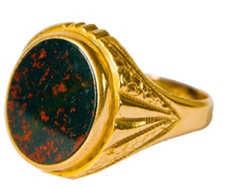In an interview about her recently published article in the magazine Modern Stones Digested, she explains how she came across this remarkable finding. “I’m not a gemologist or scientist at all, but working with beads and gemstones for over 20 years I have naturally taken an interest in various stones and their properties. Bloodstone is considered a healing stone that helps detoxify and cleanse the blood.”
Humphrey further explains, “I was reading about ancient beliefs regarding gemstones and medicine, and I noticed a trend from about the 11th century and earlier. It seemed that in ancient times, when a person suffered from swelling, for whatever reason, one treatment was to use ‘tha grean blodded stoned onced crashoud and poulticid abot tha swelang.’ In other words, they would crush the bloodstone and make a poultice, often with some other herbs or grasses, and wrap it around the swollen area. What caught my attention was descriptions of the patients later having ‘stroung darken blodd to givve profisies und dreammes of knowleddge.’ That seemed odd, because healthy, oxygenated blood is bright red, and de-oxygenated blood is darker red; I learned that much in high school. I also kept thinking about the “prophesies and dreams” that were mentioned, and one thought led to another, and to make a long story short I finally contacted the Gemillogical Institute of the United States and was able to team up with Dr. B.S. Grannitte who conducted more research and was able to do more testing of bloodstone.” Humphrey explains that “it turns out that in ancient times people thought that very dark red blood was a sign of strength. Bloodstone, it so happens, kind of ‘sucks’ out the iron in the blood, along with the oxygen it helps to carry, and therefore reduces the oxygen throughout the bloodstream. This also explains the ‘prophesies and dreams,’ for these people would have been experiencing problems associated with low oxygen, such as hallucinations. “Today there is very little risk associated with wearing bloodstone,” Humphrey explained. “People don’t usually crush the stone and apply it directly to the skin or possibly even an open wound. Still, it doesn’t hurt to be careful. When wearing bloodstone I prefer to use it in jewelry that lays on clothing, rather than directly on my skin.” Humphrey noted that “most of the credit for this discovery goes to Dr. Grannitte and others at the GIUS who did all of the hard work. It kind of makes you think about the origin of some stone names, though. The origin for the name ‘bloodstone’ may have more to do with these properties than just the coloring. That’s why I’m currently looking into the history of spleenite, a purple-ish stone with a similar history for healing diseases of the blood.” Humphrey is the owner of Bead In Hand at 145 Harrison Street in Oak Park, Illinois, where she sells beads, beading supplies, tools and more, and also offers classes, parties and jewelry repair. A copy of her article can also be found on her website, www.beadinhand.com.
1 Comment
B Morano
9/7/2018 01:09:22 pm
A gemologist whose name is B.S. Grannitte?. Really?
Reply
Leave a Reply. |
AuthorWe love April Fools' Day, when tongue-in-cheek is all good fun. Archives
April 2019
Categories |
- Home
- The Bead In Hand Store
- Free Tips & How To's
- Classes
- Calendar
- Special Events
- About Us
- Design & Repair Services
- Hours, Directions & Contact Info
- Back
- Bead Challenges >
- 2015 So Soft
- 2014 LogoCentric
- 2012 Rock On!
- 2011 Uniquely Yours
- 2011 Some Like It Hot
- 2010 Beaded Calendar Pictures
- 2008 Going Green Challenge
- 2007 Beaded Animals
- 2006 Beaded Good Luck Charms
- 2005 Beaded Birds
- 2004 Beaded Flatware
- 2003 Beaded Hands
- 2002 Salt and Pepper Shakers
- 2001 Beaded Cow Creamer


 RSS Feed
RSS Feed
